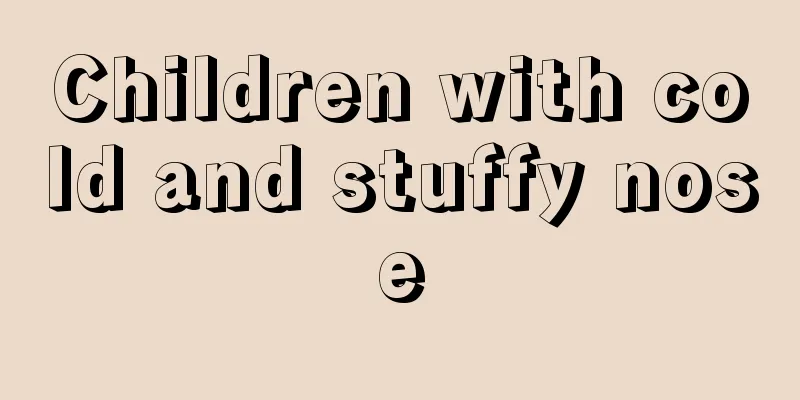Children with cold and stuffy nose

|
Colds and fevers are the most common diseases among children, and the most typical symptom of a cold in children is nasal congestion. If the nasal congestion lasts for a long time and is not treated, it may develop into rhinitis. This shows how serious the harm is. Therefore, many mothers will be very anxious when their children have nasal congestion, because they don’t know what to do if their children have a cold and nasal congestion, and they can’t find a solution. Generally speaking, for older children, nasal congestion is easier to treat and they can take some appropriate medications. However, if it is for a very small baby, you can use a cotton swab to clean the secretions in the nose when the nose is blocked. And because the baby is too small, taking cold medicine is not the best solution, so what should you do? 1. Clean nasal secretions: You can use a soft cotton swab to gently roll out the nasal secretions. If the secretions are too hard, you can drop a little breast milk or clean water into it to soften it before rolling it out. 2. Relieve nasal mucosal congestion and edema: drop 0.5% inositol ephedrine nasal drops on a swabb, then insert it into one nasal orifice and gently rotate it for a few weeks. After staying for a few seconds, take it out and then continue in another nasal orifice, three times a day. 3. Relieve exterior symptoms and open up the orifices: squeeze about 50-100 ml of breast milk into a small bowl, take 1-2 scallions (with roots), wash them and put them into the milk, steam them in water for 5-10 minutes (you can smell the fragrance of scallions), take them out and let them cool, then feed them to the baby with a spoon. It has the effect of resolving exterior symptoms and opening up the orifices to treat colds and nasal congestion. Or press the Yingxiang points in the nasolabial groove on both sides of the nose several times a day, 10 times each time, which can clear the blocked nasal cavity, so that the child is less likely to have breathing difficulties when feeding. 4. If your baby’s nose is blocked in the early stage of a cold, you can put slightly scalding ginger powder on the soles of the baby’s feet when the baby is sleeping at night. This can help the nose breathe smoothly and the cold heal faster. Method: Cut the ginger into shreds and fry in a dry pan until it is dry and the ginger aroma comes out (it’s okay if it’s a little mushy). Put the fried shredded ginger into a small gauze bag and then stick the gauze bag with the slightly hot shredded ginger on the soles of the baby’s feet. (Be sure not to make the ginger too hot to avoid scalding your baby.) 5. Hot compress method: A stuffy nose may be caused by the baby's fontanelle being cold. Mothers can use a thick towel to place it on the radiator or wrap it around a container of boiling water to release heat. You can warm the baby's fontanelle for a while and continue to apply hot compress until the baby's forehead is sweating. If you cannot tell whether the baby's fontanelle is cold, you might as well give it a try. It will not harm the baby. 6. If your baby has a stuffy nose due to a cold, you can soak the white part of scallion in water, cut the white part of scallion into shreds (to make it easier to absorb the flavor), put it into boiling water, and fumigate the baby's mouth and nose while it is hot. This method is effective for the baby's nasal congestion caused by cold. 7. Wash the nose with salt water. You can add salt to cold boiled water, wet a small cotton swab, and clean the baby's nasal cavity. Be gentle when cleaning. Cleaning every day can relieve the symptoms of nasal congestion. The above is a specific explanation of what to do if a child has a cold and a stuffy nose. For children with a stuffy nose, it is most uncomfortable when sleeping. In order to relieve the symptoms of nasal congestion, you can let your child sleep on the right side. Generally, sleeping on the side can ensure that one nose is ventilated, which can not only relieve the symptoms of nasal congestion, but also avoid the possibility of the left side pressing on the heart. |
<<: Is hand, foot and mouth disease serious?
>>: Eight-month-old baby development indicators
Recommend
How to treat red and swollen foreskin in children?
Phimosis is a common disease among men. If not tr...
What are the methods to relieve itching of prickly heat in children?
?Every summer is a time when mothers are more ner...
Treatment for baby's fever and swollen gums
As parents, when our children have a fever and th...
Are there any side effects of using enema for children?
Many parents will use enema on their babies when ...
What should I do if my child has gastritis?
Chronic gastritis refers to various chronic infla...
Is it normal for a 7-year-old to fart frequently?
Farting is a very common phenomenon in our lives....
Why does my child keep turning over when sleeping at night?
Parents all hope that their babies can have a goo...
What to eat for children with precocious puberty
Today's parents pay more attention to their c...
What foods are good for calcium supplementation in 10-year-old children?
Every parent hopes that their child can be health...
Baby's nasal discharge is yellow and sticky
Many young parents pay special attention to their...
Is nephritis easy to treat in children?
When a child gets nephritis, parents are most wor...
What is the reason for the baby's sudden loss of appetite?
Babies are prone to many diseases. When treating ...
What should I do if my child has a big belly? It is important to develop the habit of exercising!
Some children have particularly big bellies, whic...
What should children eat to grow taller?
There are many factors that affect children's...
What should a 2-year-old baby with anemia eat?
Everyone knows a simple truth. Since having child...









